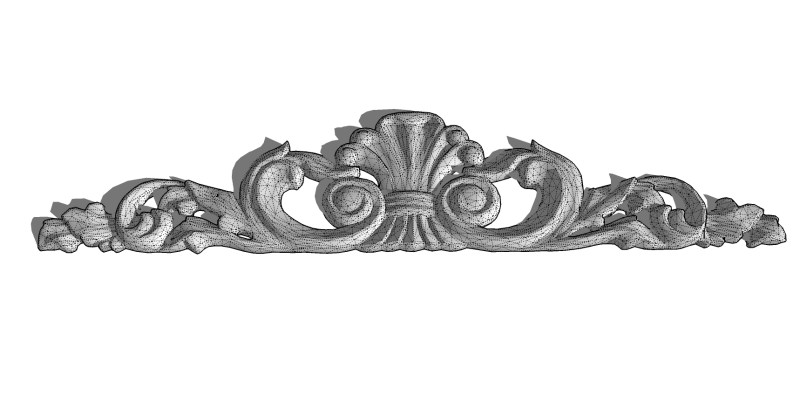Simulate a Wood Carving?
-
@gaieus said:
That's [nice] UV mapping, Al. It is definitely not a nativeSketchUp, planar projection...
These solid textures - which many rendering packages can do - do not use UV mapping. Instead they define a 3D texture - defining how the wood grain appears based on location in 3D space, rather than a position on the surface - and then "cut" the wood out of the 3D texture.
I first saw it when we did our RenderMan interface to ARRIS Cad in the early 90's. But until we had a good sculpting system like SketchUp, it was hard to find good models to demonstrate the technique.
-
@dave r said:
Maybe this would give you some ideas about how to make those tapered flutes? The ones I did are all the same and, compared to your example, inside out but the process would be similar. You only need to draw half of it of course.
Dave, I'm having a hard time doing the rotation to create the "cone" along the 15 degree line as described in your videos. I created the curved and welded line that is to become the "petal" of the fan, along the blue axis. Selected the curved line then snapped the red axis with the rotate tool, but this is where I get lost, I must be missing a step somewhere cause when I try to rotate no matter what I try I end up with cylinder, it won't use the 15 degree line as it's rotation point.
I hope this explanation makes sense.
-
OK, figured out what I was doing wrong, I wasn't following the 15 degree line with holding the mouse button down.
But how did you make 6 separate new lines in one click like that?
-
@mgfranz said:
OK, figured out what I was doing wrong, I wasn't following the 15 degree line with holding the mouse button down.
But how did you make 6 separate new lines in one click like that?
Never mind, got that figured out too...

-
-
Thanks Pete. I haven't had time to do anything to show here so I'm glad you did.
-
Hi Pete,
I have reduced the polygons with Cinema 4D by 50%. But the quality seems worse than in your model. The size is still 1.81 MB. The method that you have achieved it? Or is it your secret?
Charly
-
Charly, I've been extremely busy at my day job doing some upgrades to our 70 anesthesia machines so I haven't even had time to open Pete's file to compare it to the way I managed to get the file size down. The way I did it, however was to split the carving in half along its line of symmetry. Then I deleted one half. There was a lot of excess geometry I could delete as well. My version doesn't have a back surface. These things are designed to be applied to another surface so the back isn't needed. Getting rid of it eliminated a large number of edges and faces. Once the half was cleaned up, I made it a component, copied it and flipped the copy. The seam line was then hidden so it looks like one piece.
-
Hi to All,
I have again a question to all SketchUp users. If you keep selecting the back of a high polygon model is always a lot to be polygons that are not included. And this has to be erased manually. Is there a trick to select all parts below the surface?
Charly
-
Sorry Dave,
It was not my intention to discourage you from important work. I also expect to a question no lightning-like response. I am happy if I get some time for a response. I know that there are more important things than Sketchup. I now have a bit more time, since I'm retired.
Charly
-
Turn off perspective then pick one of the standard views and use a left-to-right bounding box selection technique.
Best,
Jason. -
Hi Jason,
thanks for your tip. But I still can not catch all the polygons.
Charly
-
Charly, I would intersect a surface with the shape at the point where I want to cut it, as it appears you have. Then I would set up the standard view and parallel projection. A right to left selection box made so it just misses the cutting plane should select most if not all of the stuff you want to get rid of. Look closely for any remaining edges and delete those either manually or zoom in closer and make additional selections.
By the way, no worries about me putting off more important work. I only respond here on the forum when I do have time. I'm glad to actually have that time now, though.
-
Intersect is easier.

-
-
Yeah I got the right to left thing mixed up
 -- I have a hard time with right and left, when somebody asks directions I always use east, west, north, and south... which drives my wife nuts.
-- I have a hard time with right and left, when somebody asks directions I always use east, west, north, and south... which drives my wife nuts.I think it's a byproduct of being semi-ambidextrous.
Solid tools are the fastest, but I assumed you didn't have those.
Best,
Jason. -
No worries, Jason.
You're right about the Solid tools although with something like this applique piece, there's a good chance you'd spend a lot of time cleaning it up just to make it show as a solid group/component.
-
Solid tools are the fastest but a model that is not solid will not work, so going back to the old intersect method works.
Advertisement









